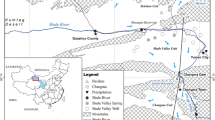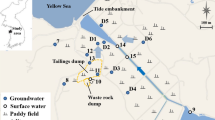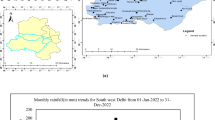Abstract
The main objective of this study was to identify the main sources and processes that control SO4 2− groundwater concentrations in the **ghuiqu irrigation district of China using isotope analysis. Lysimeter irrigation experiments and numerical modeling were used to assess the impact of long-term irrigation practices on sulfate transport, when different sources of irrigation water were used. SO4 2− concentrations in the groundwater of the entire irrigation area increased significantly from the years 1990 (a mean value was 4.8 mmol L−1) to 2009 (a mean value was 9.84 mmol L−1). The δ34S-SO4 2− values (ranging from +5.27 to +10.69 ‰) indicated that sulfates in groundwater were initially predominantly derived from dissolution of minerals. However, no soluble sulfate minerals (gypsum and/or mirabilite) were detected after 1990. To better understand this seeming anomaly, water content and SO4 2− data were collected before and after the field irrigation experiment and analyzed using the HYDRUS-1D and HP1 software packages. The experimental data were also used to assess sulfate leaching when different sources of irrigation water were used under current irrigation practices. The dissolved sulfate concentrations in the soil profile increased significantly when groundwater was used for infiltration compared to the use of surface water. Irrigation water sources had a great impact on the increase of sulfate concentrations in the shallow groundwater, especially when groundwater with elevated concentrations was used for irrigation.







Similar content being viewed by others
References
Allen RG, Pereira LS, Raes D, Smith M (1998) Crop evapotranspiration—guidelines for computing crop water requirements. In: Irrigation and Drainage. Paper 56. FAO, Rome, Italy
Bellier O, Mercier JL, Vergely P, Long C, Ning C (1988) Evolution sédimentaire et tectonique du graben cénozoque de la Wei He (province du Shaanxi, Chine du Nord). Bull Soc Géol Fr IV(6):979–994
Böhlke JK (2002) Groundwater recharge and agricultural contamination. Hydrogeol J 10:153–179
Forkutsa I, Sommer R, Shirolova YL, Lamers JPA, Kienzler K, Tischbein B, Martius C, Vlek PLG (2009) Modeling irrigated cotton with shallow groundwater in the Aral. Sea Basin of Uzbekistan: II. Soil salinity dynamics. Irrig Sci 27:319–330
Gao C (2004) Test of the irrigation technique in the border field. J Northwest Hydroelectr Power 1:140–141 (in Chinese with English abstract)
Gonçalves MC, Šimůnek J, Ramos TB, Martins JC, Neves MJ, Pires FP (2006) Multicomponent solute transport in soil lysimeters irrigated with waters of different quality. Water Resour. Res. 42. W08401. doi:10.1029/2005WR004802
Groundwater Investigation Report of **ghuiqu, **ghuiqu Irrigation District (1983) **’an, Shaanxi Province, China, pp 112 (in Chinese with English abstract)
Hanson BR, Šimůnek J, Hopmans JW (2008) Leaching with subsurface drip irrigation under saline, shallow ground water conditions. Vadose Zone J 7:810–818
Jacques D, Šimůnek J, Mallants D, van Genuchten MT (2008) Modeling coupled hydrological and chemical processes: long-term uranium transport following mineral phosphorus fertilization. Vadose Zone J 7(2):698–711
Jiang S, Pang LP, Buchan GD, Šimůnek J, Noonan MJ, Close ME (2010) Modeling water flow and bacterial transport in undisturbed lysimeters under irrigations of dairy shed effluent and water using HYDRUS-1D. Water Res 44:1050–1061
Kaown D, Koh D-C, Mayer B, Lee K-K (2009) Identification of nitrate and sulfate sources in groundwater using dual stable isotope approaches for an agricultural area with different land use (Chuncheon, mid-eastern Korea). Agric Ecosyst Environ 132:223–231
Krouse HR, Mayer B (2000) Sulfur and oxygen isotopes in sulfate. In: Cook PG, Hercseg AL (eds) Environmental tracers in subsurface hydrology. Kluwer Academic Press, Boston, pp 195–231
Langmuir D (1997) Aqueous environmental geochemistry. Prentice Hall, New Jersey
Li M (1998) Overview the **ghuiqu irrigation system of expansion project construction management. Shaanxi Water Resour 2:30–31 (in Chinese with English abstract)
Li Y, Ma X, Kang S (1999) Study on the optimal conjunctive use of surface and underground water in **ghui irrigation region. Trans Chin Soc Agric Eng 1:130–134 (in Chinese with English abstract)
Liu G (2002) Some sediment problem of the headwork project in **ghuiqu. Tech Seepage Cont 2:37–42 (in Chinese with English abstract)
Liu X (2005) Discussion on optimized arrangement of water resources in **ghuiqu irrigation area of Shaanxi province. J Water Resour Archit Eng 3(2):62–64 (in Chinese with English abstract)
Liu Y (2010) Dynamic variation characteristics and cause analysis of underground water level in **ghui irrigation district. Yangtze River 8:100–107 (in Chinese with English abstract)
Liu Y, Zhu H (2011) Characteristics of inferior variation of water environment and regulating capacity of groundwater reservoir in **ghui Canal Irrigation District of China. Trans Chin Soc Agric Eng 6:19–23 (in Chinese with English abstract)
Liu XH, Li L, Wang Z (2011) Biogeochemistry characteristics of nitrogen in unsaturated soils of **gHuiQu irrigation district, China. In: ISWREP 2011, proceedings of international symposium on water resource and environmental protection, vol 2, pp 959–962
Liu XH, Sun SJ, Ji P, Šimůnek J (2012) Identification of nitrate sources in groundwater and modeling of nitrate transport after flood irrigation using HYDRUS-1D. Hydrol Sci J (in press)
Ma ZY, Fan JJ (2005). Sulfate forming from groundwater in western Weibei karst area, Shaanxi Province. Coal Geol Explor 33(3):45–48 (in Chinese with English abstract)
Mayer B (2005) Assessing sources and transformations of sulfate and nitrate in the hydrosphere using isotopic techniques. In: Aggarwal PK, Gat JR, Froehlich FO (eds) Isotopes in the water cycle: past, present, and future of a develo** sciences. IEA, Netherlands, pp 67–89
Mitchell MJ, Krose HR, Mayer B, Stam AC, Zhang Y (1998) Use of stable isotopes in evaluating sulfur biogeochemistry of forest ecosystems. In: Kendall C, McDonnell JJ (eds) Isotope tracers in catchment hydrology. Elsevier, Amsterdam
Parkhurst DL, Appelo CAJ (1999) User’s guide to PHREEQC (Version 2)—a computer program for speciation, batch-reaction, one-dimensional transport, and inverse geochemical calculations. Water-resources investigations, report 99–4259. Denver, Co., USA, p 312
Ramos TB, Šimůnek J, Gonçalves MC, Martins JC, Prazeres A, Castanheira NL, Pereira LS (2011) Field evaluation of a multicomponent solute transport model in soils irrigated with saline waters. J Hydrol 407(1–4):129–144
Rock L, Mayer B (2002) Isotopic assessment of sources and processes affecting sulfate and nitrate in surface water and groundwater of Luxembourg. Isotopes Environ Health Stud 38(4):191–206
Rock L, Mayer B (2009) Identifying the influence of geology, land use, and anthropogenic activities on riverine sulfate on a watershed scale by combining hydrometric, chemical and isotopic approaches. Chem Geol 262:121–130
Schaap MG, Leij FJ, van Genuchten MT (2001) Rosetta: a computer program for estimating soil hydraulic parameters with hierarchical pedotransfer functions. J Hydrol 251:163–176
Shanley JB, Mayer B, Mitchell MJ, Michel RL, Bailey SW, Kendall C (2005) Tracing sources of stream water sulfate during snowmelt suing S and O isotope ratios of sulfate and 35S activity. Biogeochemistry 76:161–185
Šimůnek J, Šejna M, Saito H, Sakai M, van Genuchten MT (2008) The HYDRUS-1D software package for simulating the movement of water, heat, and multiple solutes in variably-saturated media. Version 4.0 HYDRUS Software Series 3, Department of Environmental Sciences, University of California Riverside, Riverside, CA, USA, pp 315
Šimůnek J, van Genuchten MT, Šejna M (2008b) Development and applications of the HYDRUS and STANMOD software packages, and related codes. Vadose Zone J 7(2):587–600
Šimůnek J, Jacques D, Twarakavi NKC, van Genuchten MT (2009) Modeling subsurface flow and contaminant transport as influenced by biological processes at various scales using selected HYDRUS modules. Biologia 64(3):465–469. doi:10.2478/s11756-009-0106-7
Szynkiewicz A, Witcher JC, Modelska M, David MB, Lisa MP (2011) Anthropogenic sulfate loads in the Rio Grande, New Mexico (USA). Chem Geol 283:194–209
Van Donkelaar C, Hutcheon IE, Krouse HR (1995) δ34S, δ18O, δD in shallow groundwater: tracing anthropogenic sulfate and accompanying groundwater/rock interactions. Water Air Soil Pollut 79:279–298
van Genuchten MT (1980) A closed form equation for prediction the hydraulic conductivity of unsaturated soils. Soil Sci Soc Am J 44:892–898
West LJ, Truss SW (2006) Borehole time domain reflectometry in layered sandstone: impact of measurement technique on vadose zone process identification. J Hydrol 319:143–162
Zhao A, Fei LJ (2006) Molding the conjunctive use of surface water and groundwater in irrigation area—take **ghuiqu for an example. J Northwest Hydroelectr Power 22(5):23–27 (in Chinese with English abstract)
Acknowledgments
This work was supported by the “Program on creation and intellectual importation for hydro-ecology and water security in the arid and semiarid regions” of the Ministry of Education and Foreign Expert Bureau of China (“111” project), and the project “Improving water use efficiency, and the experiment and demonstration of promoting new socialist countryside construction in the irrigation areas” of the Department of Water Resources of Shaanxi Province. Special thanks also go to the **ghuiqu administration for data sharing.
Author information
Authors and Affiliations
Corresponding author
Rights and permissions
About this article
Cite this article
Liu, X., Šimůnek, J., Li, L. et al. Identification of sulfate sources in groundwater using isotope analysis and modeling of flood irrigation with waters of different quality in the **ghuiqu district of China. Environ Earth Sci 69, 1589–1600 (2013). https://doi.org/10.1007/s12665-012-1993-4
Received:
Accepted:
Published:
Issue Date:
DOI: https://doi.org/10.1007/s12665-012-1993-4




